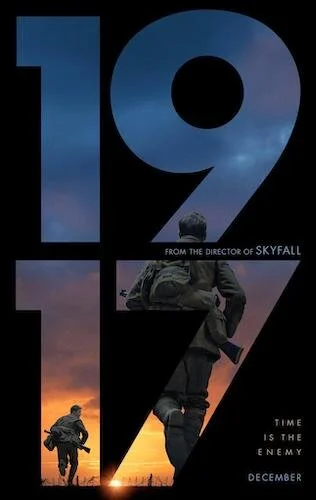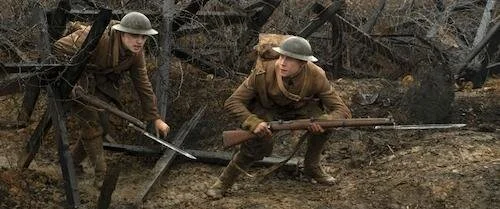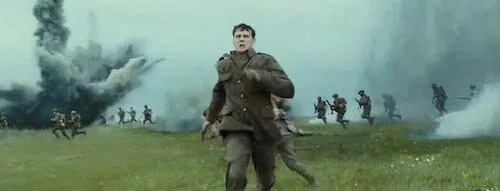1917
Okay, I’m going to tell it like it is. 1917 is beyond the gimmick that you’re all interested about. Yes, most of the film is cut to resemble one continuous shot in real time, but there is so much more to see in 1917 than this technical wizardry alone. With complete confidence, I can say that this is Sam Mendes’ finest work since American Beauty, and maybe one of the greatest achievements for Roger Deakins as well. The hype is real. 1917 is the last-minute awards-season crasher that can very well dominate the next few months, and I have absolutely no problem with it doing so. See, gimmicks make films interesting to watch, since you are going for that particular purpose (amongst others, I’m sure). Experiments like 1917, where the gimmick is just the foundation of the film, aren’t just refreshing: they’re rewarding.
See, your eyes dart around when two hours is glued together to create the illusion of one single shot (or mostly one shot, anyway). You aren’t necessarily being guided. For Deakins, this means the ability to toy with the mise en scène is in full effect. I can guarantee that 1917 needs to be viewed more than once, because so much of the film is a guessing game of where you should look. Let’s say a story element gets introduced. To avoid spoilers, I’ll make my own plot point up that is not in the film at all. So a main character finds a cheeseburger on the ground, but it could be a trap. See? No way a cheeseburger would be in the middle of a World War I battlefield. You begin to look throughout the entire film for similar food related traps. Apply this to so many different plot points. You will feel as though you are on the pitch with these soldiers. You’ll be in an invincible bubble of course, but the anxiety and chaos has been replicated perfectly.
1917 follows a near-suicide mission for two soldiers, to report the authorized abortion of a scheduled attack.
The timing of each moment is so succinct as well. Mendes (a first time cowriter here) and Krysty Wilson-Cairns know exactly what to do to salvage empty moments, which there are many of considering the real-time angle of the film. Not a second feels wasted here. You will already be amazed by the illusion of the single shot, so seeing how much substance gets crammed into the film will likely entice you even more. Toss in Mendes’ mind boggling use of choreography, and 1917 becomes an astounding effort you can’t even wrap your head around. So, it’s spellbinding. What makes it special is that it tells a commanding story to boot. You come for the thrills, and you leave with the absorbing storytelling.
The single-shot adds so much context to the tale. It makes you aware of time length in such a mission. It causes you to fixate on every little detail like the lead soldiers. It makes you feel like you are a part of each scene. To make it not a dizzying headache, everything has to be orchestrated just so. Deakins and Mendes fulfill this movie-making magic, yet it bizarrely feels shot as though each beat is an invisible “edit”. The camera will wind one way, and land on a particular angle, without drifting too much afterward. The storyboarding was abundantly important, as you can feel each and every drawn image being implemented here. Imply that this is a real experience, but a story is still a story. That means knowing downtime, structure, and other important pieces of the greater whole.
The combat sequences feel even more astounding, considering the amount of work that goes into each and every lengthy “scene”.
All of this work is meant to illustrate the risks involved in a mission like the one displayed here. Two soldiers are sent towards the German army’s territory in order to call off a planned attack, as the evacuation of the German fleet is deemed to be a strategic trap to ambush British troops. The urgency of this message makes you more aware of how quickly time drifts by, rather than how long this take is (or seems). With that, I will say no more. The less you know about this whirlwind of a thriller, the better. Just understand that 1917 is an emotional rollercoaster, that will bowl you over with its incredible methods of conveying a dire situation. Seeing how 1917 has been assembled, and noticing how many craftsmen are at the top of their game, who knows. Maybe 1917 will be the film to beat at the Academy Awards next year. Time will tell very soon.
Andreas Babiolakis has a Masters degree in Film and Photography Preservation and Collections Management from Ryerson University, as well as a Bachelors degree in Cinema Studies from York University. His favourite times of year are the Criterion Collection flash sales and the annual Toronto International Film Festival.







